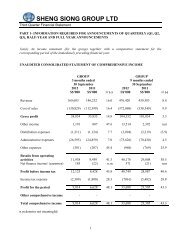FY 2011 Annual Report - Sheng Siong
FY 2011 Annual Report - Sheng Siong
FY 2011 Annual Report - Sheng Siong
You also want an ePaper? Increase the reach of your titles
YUMPU automatically turns print PDFs into web optimized ePapers that Google loves.
48 <strong>Sheng</strong> <strong>Siong</strong> <strong>Annual</strong> <strong>Report</strong> <strong>2011</strong><br />
Notes to the Financial Statements<br />
3 Basis of preparation (Continued)<br />
3.5 Changes in accounting policy<br />
From 1 January <strong>2011</strong>, the Company has applied the revised FRS 24 Related Party Disclosures (2010) to identify<br />
parties that are related to the Company and to determine the disclosures to be made on transactions and<br />
outstanding balances, including commitments, between the Company and its related parties. FRS 24 (2010)<br />
improved the definition of a related party in order to eliminate inconsistencies and ensure symmetrical<br />
identification of relationships between two parties.<br />
The adoption of FRS 24 (2010) does not have a material impact on the disclosures of transactions and<br />
outstanding balances, including commitments, with these related parties for the current and comparative years<br />
in Note 24 to the financial statements. The adoption of FRS 24 (2010) affects only the disclosures made in the<br />
financial statements. There is no financial effect on the results and financial position of the Company for the<br />
current and previous financial years.<br />
4 Significant accounting policies<br />
The accounting policies set out below have been applied consistently to all periods presented in these financial<br />
statements.<br />
4.1 Basis of consolidation<br />
Acquisitions of entities under common control<br />
Business combinations arising from transfers of interests in entities that are under the control of the shareholders<br />
that control the Group are accounted for as if the acquisition had occurred at the beginning of the earliest<br />
comparative period presented or, if later, at the date that common control was established. The assets and<br />
liabilities acquired are recognised in the combined financial statements at the carrying amounts recognised<br />
in the acquired entities’ financial statements. The components of equity of the acquired entities are added to<br />
the same components within Group equity. Any difference between the cash paid for the acquisition and net<br />
assets acquired is recognised in equity.<br />
Subsidiaries<br />
Subsidiaries are entities controlled by the Group. Control exists when the Group has the power to govern the<br />
financial and operating policies of an entity so as to obtain benefits from its activities. In assessing control,<br />
potential voting rights that presently are exercisable are taken into account.<br />
The financial statements of subsidiaries are included in the financial statements from the date that control<br />
commences until the date that control ceases. The accounting policies of subsidiaries have been changed<br />
where necessary to align them with the policies adopted by the Group.<br />
Accounting for subsidiaries<br />
Investments in subsidiaries are stated in the Company’s statement of financial position at cost less accumulated<br />
impairment losses.



